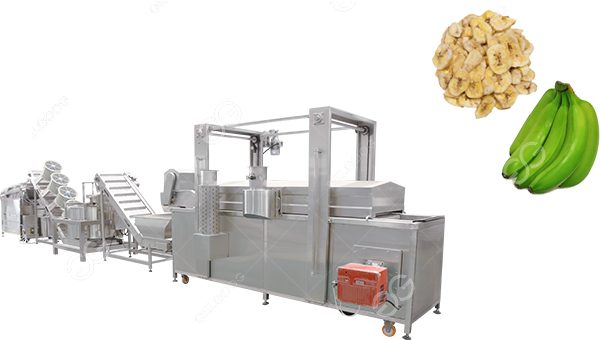Banana chips, a popular snack enjoyed worldwide, require a systematic manufacturing process to ensure quality and consistency. From sourcing raw bananas to packaging the final product, each step demands specialized equipment tailored to optimize efficiency and maintain product standards. What equipment is needed in making banana chips? Let’s delve into the essential equipment needed for producing banana chips in a factory setting.

Blanching machine:
Blanching is a crucial step in the banana chip production process as it helps preserve color, flavor, and texture while also eliminating bacteria and enzymes. A blanching machine facilitates this process by quickly immersing the bananas in hot water or steam, followed by a rapid cooling phase. This equipment ensures uniform blanching, preparing the bananas for subsequent processing stages.
Peeling machine:
Peeling bananas manually can be time-consuming and inefficient, especially on an industrial scale. A peeling machine automates this task, efficiently removing the skins from the blanched bananas. These machines are designed to handle large volumes of bananas swiftly, streamlining the production process.
Slicing machine:
After peeling, the bananas need to be sliced into thin, uniform pieces to ensure consistent frying and texture in the final product. Slicing machines come in various designs, including rotary slicers and blade slicers, capable of cutting bananas into precise thicknesses. These machines contribute to product uniformity and reduce processing time.
Frying machine:
Frying is a critical step in banana chip production, where sliced bananas are immersed in hot oil until they reach the desired crispiness and golden hue. Frying machines feature temperature controls, conveyors, and immersion systems to ensure even frying and efficient oil usage. They play a vital role in achieving the desired taste and texture of banana chips.
Deoiling machine:
Excess oil on banana chips can affect their shelf life and quality. Deoiling machines remove surplus oil from the fried chips, enhancing their crispiness and prolonging shelf life. These machines employ centrifugal force or air-drying techniques to extract oil efficiently while maintaining product integrity.
Packaging machine:
Once the banana chips are fried and deoiled, they need to be packaged promptly to maintain freshness and prevent moisture absorption. Packaging machines come in various types, including vertical form-fill-seal machines and automatic pouch packaging machines. These machines accurately weigh, fill, seal, and label bags or pouches, ensuring product safety and shelf appeal.
In addition to the primary equipment mentioned above, a banana chip manufacturing facility may also require auxiliary equipment such as conveyors, washing stations, drying systems, and quality control devices to monitor product parameters throughout the production process.
Efficient operation and maintenance of these banana chips making machines are essential for maximizing productivity, minimizing waste, and ensuring product consistency. Regular cleaning, calibration, and inspection procedures should be implemented to uphold food safety standards and comply with regulatory requirements.
In conclusion, the production of banana chips in a factory environment demands a range of specialized equipment tailored to each stage of the manufacturing process. From blanching and peeling to frying, deoiling, and packaging, these machines play a pivotal role in delivering high-quality banana chips to consumers worldwide.